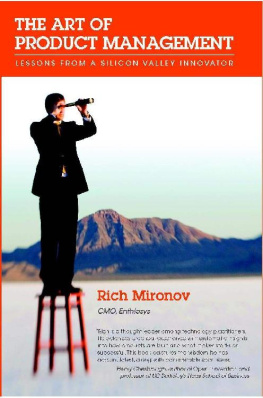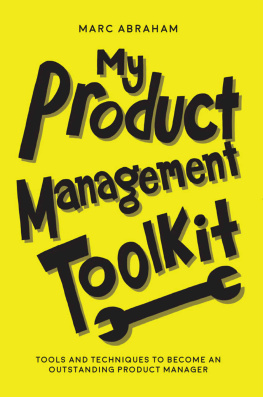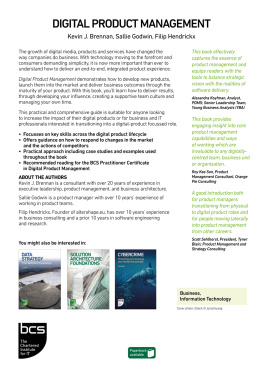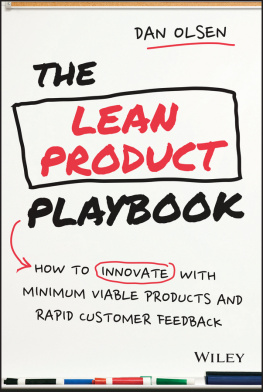Thank you for purchasing this Free Press eBook.
Sign up for our newsletter and receive special offers, access to bonus content, and info on the latest new releases and other great eBooks from Free Press and Simon & Schuster.

or visit us online to sign up at
eBookNews.SimonandSchuster.com


THE FREE PRESS
A Division of Simon & Schuster Inc.
1230 Avenue of the Americas
New York, NY 10020
www.SimonandSchuster.com
Copyright 1997 by The Free Press
All rights reserved,
including the right of reproduction
in whole or in part in any form.
THE FREE PRESS and colophon are trademarks
of Simon & Schuster Inc.
Manufactured in the United States of America
10 9
Library of Congress Cataloging-in-Publication Data
Meyer, Marc H.
The power of product platforms: building value and cost leadership / Marc H. Meyer, Alvin P. Lehnerd.
p. cm.
Includes bibliographical references and index.
ISBN 978-1-4516-5530-8
New productsManagement.
2. Product management. I. Lehnerd, Alvin P. II. Title.
HF5415.153.M49 1997
658.575DC20 96-33508
CIP
ISBN-13: 978-1-4391-3744-4 (eBook)
If wishes were horses, beggars would ride. But of course wishes are not realities. Simply wishing for an escape from chaos and crisis to a more harmonious future will never get you there.
We dedicate this book to our mentors and colleagues from whom we have so richly learned, and to our readers who we hope will use the lessons conveyed herein to transform their own wishes into a more productive, prosperous future for themselves and their corporations.
Contents
Preface
W hen a companys products are robusthighly functional, elegant in their design, fairly priced, and a pleasure to usethe corporation itself will be equally robust. It will grow in the good times, weather the bad times, and make the difficult transition from one generation of technology to the next.
This book is about creating and managing extraordinary products. While many companies have great difficulty mastering this activity, we have been fortunate to work with firms in a range of industries that have successfully developed new products and integrated manufacturing processes with new product designs. Those experiences, which have complemented our academic research, have been the source of our insights. As authors, we wish to share this information with all those responsible for the vitality of the enterprise: the chief executive, his or her management team, and the Board. We believe this book will be highly useful for both large corporations and those of smaller size, including entrepreneurs, all of whom depend on the excellence of their new products for growth.
For many companies, the road to growth, admiration, and customer loyalty has been built on excellence in new product development. Only a handful, however, have been able to sustain that excellence through eras of changing technology and leadership. Motorola, which began as a maker of car radios in the 1930s, switched to making walkie-talkies during World War II and then redefined itself again, this time in the field of consumer electronics. As that field matured, Motorolas leadership successfully guided the company into exciting new markets for semiconductors, pagers, and cellular communications. Each transition enriched existing competencies with new technologies and business skills. Hewlett Packard, too, started during the 1930s, as a maker of electronic testing devices. Over the years it successfully changed direction as new markets and new technologies appeared, branching into high-end calculators, plotters and printers, medical equipment, workstations, PCs, and systems integration services. Similarly, Intel charges forward year after year with new and better microprocessors that make its existing designs obsolete. Microsoft must also be listed among this elite group of companies; it continues to enhance its technology for the desktop, the corporate network, and, most recently, the Internet. Each of these companies has recognized and responded to new market opportunities by leveraging core skills and technologies in the form of new products.
The industrial roadway is also littered with the wreckage of companies that have left their products unattended. Those companies lost their technological edge, industry leadership, and customers. The list of the fallen extends far back in industrial history. In the nineteenth century, for example, Boston was known for its preeminence in harvesting ice from local ponds and shipping it at great profit to the far corners of the world. When mechanical ice manufacturing was invented by an Englishman during the time of the American Civil War, the great Boston ice companies collectively said, That is not the ice business and continued to invest heavily in traditional ice harvesting and distribution technologies. Within just a few decades, their customers had abandoned them for manufactured ice, which could be produced more reliably and at lower cost. A century later, the same tragedy replayed itself with many of the Boston area minicomputer manufacturers, who believed their own proprietary operating systems could withstand the onslaught of open systems.
What makes companies like Motorola, Hewlett Packard, Intel, and Microsoft different from those that fail to advance their products? Why is it that they continue to offer exciting new products while others do not? It cannot be for lack of desire. What manager would not want to hold the keys to the future, the technologies that render existing ways of doing things obsolete? Nor can it be for a lack of new management ideas. Consider QFD (quality functional deployment), stage-gate control systems, reengineering, ISO 9000, core competencies, and mass customization. Such innovations are often tried one year and abandoned the next. While each may have value, taken together they consume an enormous amount of the organizations energy. Too often their net effect is organizational upheaval, a plague of meetings, countless reports, exorbitant consulting bills, and unmanageable complexity in downstream activities such as manufacturing and support. Perhaps most damaging is that the implementation of these management fads can divert attention from the renewal of products and services. Managements eye gets taken off the ball, away from its customers and products. Tocqueville noted in the nineteenth century that Americans had a tendency to become slaves to slogans. If he were observing the corporate scene today, he might well come to the same conclusion.
Fads and slogans notwithstanding, what differentiates innovative companies from others is the constancy of their devotion to strong products. Their managers need no lectures about the need to constantly improve products over time and to find new markets for their core technologies. Further, they understand that long-term success does not hinge on any single product. They know they must generate a continuous stream of value-rich products that target growth markets. Such products form the product family, individual products that share common technology and address related market applications. It is those families of products that account for the long-term success of corporations.
Product families do not have to emerge one product at a time. In fact, they are planned so that a number of derivative products can be efficiently created from the foundation of common core technology. We call this foundation of core technology the product platform, which is













